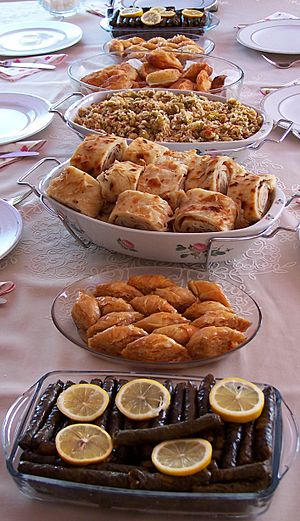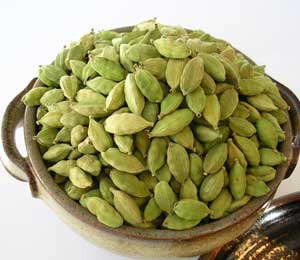Cuisine facts for kids

A cuisine is a special way of cooking that uses unique ingredients, methods, and dishes. It's usually linked to a certain culture or place. What's available nearby or through trade mostly shapes a cuisine. Rules about food from religions, like Hindu, Islamic, and Jewish dietary laws, can also strongly affect a cuisine. Local food traditions, customs, and ingredients often mix to create dishes found only in one area.
Contents
What Shapes a Cuisine?
Many things influence a region's cuisine. These include the area's climate, trade between countries, religious rules, and the sharing of cooking ideas. For example, people in tropical places might eat more fruits and vegetables. People near the poles might eat more meat and fish.
The climate of an area largely decides which native foods are available. Climate also affects how food is kept fresh. For instance, foods preserved for winter by smoking, curing, and pickling are still important in world cuisines.
Trade among different countries also greatly affects a region's cuisine. Long ago, the spice trade helped spread seasonings like cinnamon, cassia, cardamom, ginger, and turmeric. These spices were key items in early trade. Cinnamon and cassia reached the Middle East over 4,000 years ago.
Sharing cooking ideas is also important for many cuisines. For example, Japan first had strong contact with the West when European missionaries arrived in the 1500s. At that time, Spanish and Portuguese frying methods mixed with a Chinese way of cooking vegetables in oil. This led to tempura, a popular Japanese dish. In tempura, seafood and vegetables are coated in batter and deep-fried.
History of Cuisines
Cuisine has a long history, going back to ancient times. As people started planning their meals more, food became a part of their culture. Rome was famous for its cuisine. Rich families would eat in their Triclinium (dining room). Their meals included many different dishes like eggs, cheese, bread, meat, and honey.
New Ways of Cooking

Cuisines are always changing, and new ones appear through new ideas and cultural mixing. One recent example is fusion cuisine. This style combines parts of different cooking traditions. It doesn't fit into just one cuisine style. It usually refers to new ideas in many modern restaurants since the 1970s.
Nouvelle cuisine (New cuisine) is a way of cooking and presenting food in French cuisine. It became popular in the 1960s. It's a modern cooking style that uses many new ideas from science, like molecular cooking. International trade brings new foods and ingredients to existing cuisines, causing changes.
For instance, hot peppers came to China from South America around the late 1600s. This greatly influenced Sichuan cuisine. It mixes its original flavors with the taste of hot pepper, creating a unique spicy and strong flavor.
Cuisines Around the World
A global cuisine is a type of cooking that is practiced all over the world. These can be grouped by the common use of main foods. This includes grains, fresh produce, and cooking fats.
Local Cuisines
Regional cuisines can differ based on what food is available and traded. They also depend on cooking traditions and cultural differences. For example, in Central and South America, corn (maize) is a staple food. In northern Europe, wheat, rye, and animal fats are common. In southern Europe, olive oil and rice are more popular. In Italy, the north uses butter and rice, while the south uses wheat pasta and olive oil.
China also has regions known for rice and regions known for noodles and bread. Across the Middle East and Mediterranean, there's a common use of lamb, olive oil, lemons, peppers, and rice. Vegetarianism is common in much of India. This makes pulses (like chickpeas and lentils) as important as wheat or rice. From India to Indonesia, spices are very common. Coconuts and seafood are used throughout that region for both food and seasonings.
Related pages
Images for kids
-
An example of Central European cuisine, the Wiener Schnitzel. It is prepared with regional ingredients and according to the local cooking style.
-
Typical Ethiopian and Eritrean cuisine: Injera (thin pancake-like bread) and several kinds of wat (stew).
-
Yassa is a popular dish throughout West Africa prepared with chicken or fish. Chicken yassa is pictured.
-
Due to Guangdong's location on the southern coast of China, fresh live seafood is a specialty in Cantonese cuisine. Such markets selling seafood are found across East Asia.
-
Traditional North Indian vegetarian thali with various curries from India. Various curry dishes are found across South Asia.
-
A market stall at Thanin market in Chiang Mai, Thailand, selling ready-cooked food. Market stalls selling food are found across Southeast Asia.
-
A Tajik feast. A large feast is commonly associated with cultures of Central Asia.
-
An English Sunday roast with roast beef, roast potatoes, vegetables and Yorkshire pudding.
-
A variety of tapas: appetizers or snacks in Spanish cuisine.
-
Beef Stroganoff, a Russian dish.
-
Bush Tucker (bush foods) harvested at Alice Springs Desert Park in Australia.
-
A Hāngi being prepared, a New Zealand Māori method of cooking food for special occasions using hot rocks buried in a pit oven.
-
Bandeja paisa from Peñól de Guatapé in Antioquia, Colombia.
-
A Jamaican patty wrapped in coco bread.
-
Buffalo wings with blue cheese dressing, served with lager beer.
See also
 In Spanish: Cocina (tradiciones) para niños
In Spanish: Cocina (tradiciones) para niños























